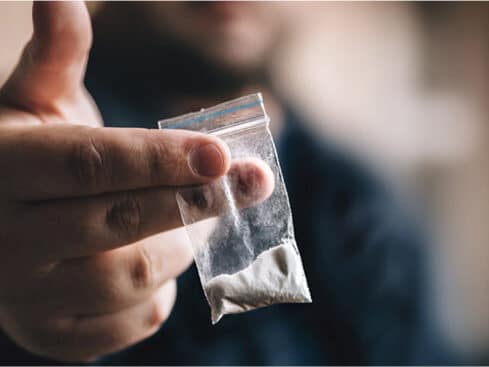To help yourself recover from a cocaine comedown, focus on self-care, including hydration, nutrition, and rest. Be open to the possibility of comprehensive cocaine addiction treatment that will help you avoid a relapse into cocaine use and future comedowns and crashes.

What Is the Cocaine Comedown?
The cocaine comedown, also called a crash, refers to psychological and physiological reactions caused by a cocaine high as its effects wear off and the drug gradually leaves your system.[3]
Cocaine is an addictive stimulant that initially produces feelings of intense euphoria, increased energy, alertness, and confidence when taken.[4] Over time, however, users usually experience uncomfortable or stressful side effects, which vary according to individual differences, the dose taken, and the frequency of use.
Cocaine comedowns affect both new users and longtime users of cocaine.
Effects of the Cocaine Crash & Rebound
Cocaine crash and rebound are commonly used terms to refer to two stages and effects related to taking cocaine.
Cocaine Crash
This is the first stage that follows a cocaine high. During this stage, cocaine’s effects begin to fade, but the drug still lingers within your system. This is what to expect:[3]
Individuals in this stage may notice an abrupt decrease in mood and energy, leading them to feel exhausted and lethargic.
Other symptoms of the crash include increased appetite, irritability, anxiety, and depression in addition to general discomfort.
Cocaine crashes vary in intensity and duration, depending on factors like how much was consumed, tolerance levels, and overall physical and mental health status.
Cocaine use over hours or days will usually produce more severe side effects, including a more severe crash, than taking just one hit and stopping use.
Cocaine Rebound
Cocaine rebound effects typically manifest shortly after experiencing a cocaine crash, usually within 24 to 48 hours. A rebound is often the body’s way of attempting to regain balance. You can expect the following:[5-6]
- The rebound period may produce side effects that are contrary to those experienced when taking cocaine.
- Symptoms may include increased anxiety, restlessness, and an overwhelming urge for cocaine use.
- Depression, fatigue, difficulty focusing, and disrupted sleeping patterns may also occur.
- These side effects could be serious and prompt the person to use cocaine repeatedly in an attempt to mitigate the discomfort, increasing the likelihood of overdose and addiction.


Identifying Crack Cocaine: How Does it Look, Feel & Smell?
How to Recover From a Cocaine Comedown: What Actually Works
Recovering from a cocaine comedown can be challenging, but there are strategies and practices that may help alleviate its symptoms and support your overall well-being during this challenging period. Every experience differs. What works for one person may not work for another.
Here are some general steps and tips that could help:[7-11]
Hydration
Stay hydrated to combat dehydration due to cocaine use. Alcohol and caffeine may further exacerbate dehydration and anxiety, so avoid these. Focus on drinking water, herbal tea, and drinks containing electrolytes.
Balanced Nutrition
Eating nutritious food can assist your body’s recovery from a cocaine crash. Eat foods that are high in vitamins, minerals, and antioxidants in order to replenish resources and support overall well-being. Healthy fats, proteins, and whole grains are recommended.
Supportive Environment
Reach out to supportive friends or family who understand what you are experiencing. Socializing can help to manage negative thoughts or feelings and provide potentially lifesaving relief from possible depression or suicidal thoughts due to cocaine comedowns.
Mindfulness & Relaxation Techniques
Deep breathing exercises, meditation, and progressive muscle relaxation may all help to lower anxiety levels and promote calm.
Avoid Triggers
Stay clear of situations or places that might trigger cravings for cocaine or other substances. While it’s tempting to simply use again, it will fuel a cycle of highs and crashes that lead to more intense comedown symptoms.
Stay Positive
Focus on the fact that comedown symptoms will eventually fade. Remember how this feels when you feel tempted to return to cocaine use.
Seek Professional Treatment
If you are repeatedly experience cocaine crashes, it’s often a sign of addiction. Professional treatment can help you to leave cocaine use in your past, so you can build a better life in recovery. Addiction treatment may involve cocaine detox, cognitive behavioral therapy, alternative therapies, and supportive activities, providing you with a structured and effective path to recovery.
Attend a Support Group Meeting
Join a support group like Cocaine Anonymous (NA). In meetings, you can form bonds with others who face similar struggles and learn from their experiences. The relationships formed in these meetings can form the basis of your support network in recovery.
- What is cocaine? National Institute on Drug Abuse. Published May 2, 2022. Accessed October 2, 2023.
- Repeated dosing with oral cocaine in humans: Assessment of direct effects, withdrawal, and pharmacokinetics Walsh S, Stoops WW, Moody DE, Shen Nan Lin, Bigelow GE., Experimental and Clinical Psychopharmacology. 2009;17(4):205-216
- Drug fact sheet: Cocaine Drug Enforcement Administration. Published April 2020. Accessed October 2, 2023.
- The neurobiology of cocaine addiction Nestler E., Science & Practice Perspectives. 2005;3(1):4-10.
- Dependence, withdrawal and rebound of CNS drugs: an update and regulatory considerations for new drugs development. Lerner A, Klein M. , Brain Communications. 2019;1(1).
- Cocaine DrugFacts National Institute on Drug Abuse. Published April 8, 2021. Accessed October 2, 2023.
- How to reduce or quit drugs Department of Health and Aged Care. Published March 4, 2020. Accessed October 2, 2023.
- Treatment of stimulant use disorder: A systematic review of reviews Ronsley C, Nolan S, Knight R, et al., Hashimoto K, ed. PLOS ONE. 2020;15(6):e0234809.
- Comparison of treatments for cocaine use disorder among adults Bentzley BS, Han SS, Neuner S, Humphreys K, Kampman KM, Halpern CH., JAMA Network Open. 2021;4(5):e218049.
- Mindfulness meditation in the treatment of substance use disorders and preventing future relapse: neurocognitive mechanisms and clinical implications Priddy SE, Howard MO, Hanley AW, Riquino MR, Friberg-Felsted K, Garland EL., Substance Abuse and Rehabilitation. 2018;Volume 9(9):103-114.
- Benefits of peer support groups in the treatment of addiction Tracy K, Wallace S., Substance Abuse and Rehabilitation. 2016;Volume 7(7):143-154.











